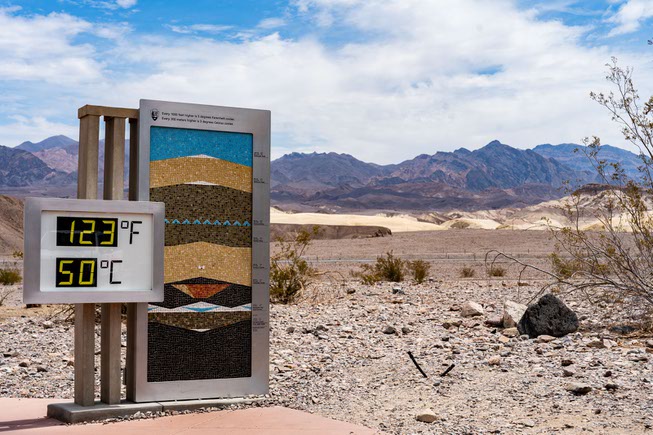
Tourists flock to Death Valley to experience the heat. Death Valley is famous for being the hottest place on earth and driest place in North America. Monday, July 17, 2023. Brian Ramos
Wednesday, July 19, 2023 | 2 a.m.
Kim Joye and Jennifer Fess hadn’t planned on coming to Death Valley National Park while the Southwest was blanketed in excessive heat advisories.
They planned to visit Great Basin National Park in east-central Nevada until car trouble kept them in Las Vegas. Instead, the Ohio residents rented a car Monday and headed to Death Valley, which was about 40 degrees hotter than Great Basin.
Despite temperatures north of 115 degrees, Death Valley was slammed with visitors — drawn in by the possibility of a record high temperature for planet Earth.
“This is the hottest we’ll ever see in our lifetime,” Joye said. “It’s not something you get to experience every day.”
They made a day out of visiting the flat, salty expanse of Badwater Basin — at 283 feet below sea level, it’s the lowest point in North America — climbing the winding drive to Artists Palette, where minerals laid bare in the mountainsides provide a colorful treat for onlookers, and the immense craggily, salty surface of Devil’s Golf Course, so named because “only the devil could play golf on such rough links.”
“We did ask ourselves a few times if we should turn around,” Fess said.
Temperatures in Death Valley, which runs along a portion of central California’s border with Nevada about 130 miles from Las Vegas, reached 128 degrees Sunday at the aptly named Furnace Creek, the National Weather Service said. Monday’s high there reached a relatively mild 118.
The hottest temperature ever recorded on Earth was 134 degrees in July 1913 at Furnace Creek, said Randy Cerveny of the World Meteorological Organization (WMO), the body recognized as keeper of world records. Temperatures at or above 130 degrees have only been recorded on Earth a handful of times, mostly in Death Valley.
“With global warming, such temperatures are becoming more and more likely to occur,” Cerveny, the WMO’s records coordinator, said in an email to the Associated Press. “Long-term: Global warming is causing higher and more frequent temperature extremes. Short-term: This particular weekend is being driven by a very strong upper-level ridge of high pressure over the Western U.S.”
Since March, Sierra Labra, a South Florida resident, has been on a mission to visit as many national parks as possible, hitting Carlsbad Caverns and White Sands in New Mexico, Guadalupe Mountains in Texas, Petrified Forest in Arizona and Joshua Tree in California, among others.
Visiting Death Valley was knocking another designation off her list — regardless of the heat.
She said she exercised caution while camping overnight Sunday in her SUV, arriving at the park late and admiring the stars. Armed with a bucket hat and a gallon jug of water, she hiked through Badwater Basin, Artists Drive and the Mesquite Flat Sand Dunes between 5 a.m. and 10 a.m. to avoid the worst of the heat.
“They were like, ‘Please don’t hike after 10 a.m.,’ and I was like ‘OK, but how? There’s so much to do,’ ” she said.
Giovanna Ponce, a public information officer for Death Valley National Park, said keeping to those 5-10 a.m. hours helps, but during summer, parts of the national park can reach above 100 degrees even before sunrise.
Ponce said this past weekend was unusually busy for the park as crowds descended on the Furnace Creek Visitor Center in hopes of witnessing its large outdoor digital thermometer reach 130 degrees, which it briefly did Sunday, or topping out the 134-degree record, which it didn’t.
The thermometer is outfitted with a sign that tells guests the display’s readings aren’t fully accurate, thanks to the urban heat island effect, but that hasn’t stopped the steady flow of visitors.
“People are hitting the usual spots,” Ponce said. “In the summer, it’s quick; get out of the car, see it, take pictures and get right back in to enjoy the air conditioning. And that’s basically all we recommend doing.”
Ponce said higher elevations in the expansive park are slightly cooler, making hiking more manageable, but it’s still not recommended.
“The general rule is every 1,000 feet you go up, it cools down anywhere between 5 and 10 degrees,” Ponce said.
International visitors often make Death Valley a stop on their carefully planned trips. Most know the heat will be intense, but by the time they realize how intense, it is too late to change their plans.
Visiting Polish nationals Daria Czajkowska and her husband, Wojtek, said the beauty of the park was worth braving the high temperatures. The couple were on their way from California to Las Vegas for a wedding and decided to visit Death Valley along the way.
“We know the best time is spring, but we didn’t have much choice,” Daria Czajkowska said. “We decided to use our chance.”
The heat was the most unbearable in Badwater Basin, she said, but it was less so at Zabriskie Point.
For nearly all of July, the world has been in uncharted hot territory, according to the University of Maine’s Climate Reanalyzer.
June was also the hottest June on record, according to several weather agencies. Scientists say there is a decent chance that 2023 will go down as the hottest year on record, with measurements going back to the middle of the 19th century.
— The Associated Press contributed to this article.

